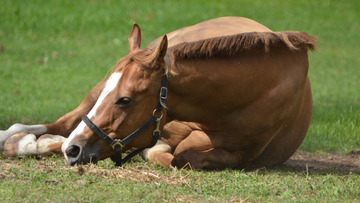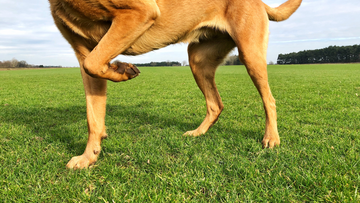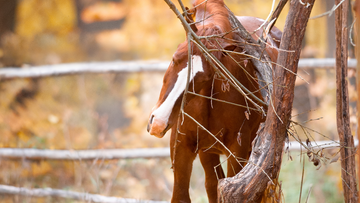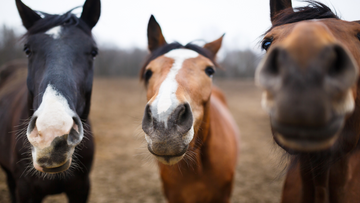 This time of the year is foaling season for most breeders. Breeders try to put foals on the ground right at the beginning of the New Year. The normal gestation period for a mare is generally 320-360 days. As the end of the gestation period comes closer, horse owners should be paying close attention to their mare(s) and looking for signs of foaling. The mare will display different stages of foaling. We will discuss all three.
Stage One
The first stage of labor for a mare is generally the longest. During stage one, the mare will act restless and may circle her stall. She may also lay down and get back up frequently. The signs she will be showing will be some-what like colic symptoms, but don’t be mistaken. The mare will show signs of abdominal discomfit by passing small amounts of manure or urine, looking at her sides, etc.
Stage Two
Stage two of labor consists of the period of time from when the mare’s “water” breaks until the foal has been delivered. This process generally takes about 15-20 minutes. The mare’s “water” will break and uterine contractions will begin. The mare will lay if she has not already done so. The mare will start to deliver the foal, feet and head first. The foal’s feet should be pointing down with one foot in front of the other. The foal will be in an amniotic sack when delivered. The amniotic sack is a thin, transparent membrane. The sack should be torn open if it has not already ripped during labor. Make sure the sack is pulled off the foals face and head so he/she can breathe.
Stage Three
The third stage of labor is the expulsion of the placenta. This will generally take 1-3 hours. This stage is extremely important. If the placenta detached prematurely without rupturing (this will happen right after the birth of the foal), consult your veterinarian. If the placenta has not been expelled after three hours, you should also consult your veterinarian.
Foaling is an exciting experience. If you are not prepared, it can be somewhat scary. Make sure you know what to expect. Most mares foal with no trouble, but make sure you have a foaling kit with basic tools in it and a few contacts in case of an emergency. Enjoy your new foal!
For more information on foaling stages, visit: http://www.equine-reproduction.com/articles/Foaling.shtml or http://horsetalk.co.nz/2012/10/17/foaling-in-mares/
This time of the year is foaling season for most breeders. Breeders try to put foals on the ground right at the beginning of the New Year. The normal gestation period for a mare is generally 320-360 days. As the end of the gestation period comes closer, horse owners should be paying close attention to their mare(s) and looking for signs of foaling. The mare will display different stages of foaling. We will discuss all three.
Stage One
The first stage of labor for a mare is generally the longest. During stage one, the mare will act restless and may circle her stall. She may also lay down and get back up frequently. The signs she will be showing will be some-what like colic symptoms, but don’t be mistaken. The mare will show signs of abdominal discomfit by passing small amounts of manure or urine, looking at her sides, etc.
Stage Two
Stage two of labor consists of the period of time from when the mare’s “water” breaks until the foal has been delivered. This process generally takes about 15-20 minutes. The mare’s “water” will break and uterine contractions will begin. The mare will lay if she has not already done so. The mare will start to deliver the foal, feet and head first. The foal’s feet should be pointing down with one foot in front of the other. The foal will be in an amniotic sack when delivered. The amniotic sack is a thin, transparent membrane. The sack should be torn open if it has not already ripped during labor. Make sure the sack is pulled off the foals face and head so he/she can breathe.
Stage Three
The third stage of labor is the expulsion of the placenta. This will generally take 1-3 hours. This stage is extremely important. If the placenta detached prematurely without rupturing (this will happen right after the birth of the foal), consult your veterinarian. If the placenta has not been expelled after three hours, you should also consult your veterinarian.
Foaling is an exciting experience. If you are not prepared, it can be somewhat scary. Make sure you know what to expect. Most mares foal with no trouble, but make sure you have a foaling kit with basic tools in it and a few contacts in case of an emergency. Enjoy your new foal!
For more information on foaling stages, visit: http://www.equine-reproduction.com/articles/Foaling.shtml or http://horsetalk.co.nz/2012/10/17/foaling-in-mares/
Blog
Your Mare: 3 Signs of Foaling

 This time of the year is foaling season for most breeders. Breeders try to put foals on the ground right at the beginning of the New Year. The normal gestation period for a mare is generally 320-360 days. As the end of the gestation period comes closer, horse owners should be paying close attention to their mare(s) and looking for signs of foaling. The mare will display different stages of foaling. We will discuss all three.
Stage One
The first stage of labor for a mare is generally the longest. During stage one, the mare will act restless and may circle her stall. She may also lay down and get back up frequently. The signs she will be showing will be some-what like colic symptoms, but don’t be mistaken. The mare will show signs of abdominal discomfit by passing small amounts of manure or urine, looking at her sides, etc.
Stage Two
Stage two of labor consists of the period of time from when the mare’s “water” breaks until the foal has been delivered. This process generally takes about 15-20 minutes. The mare’s “water” will break and uterine contractions will begin. The mare will lay if she has not already done so. The mare will start to deliver the foal, feet and head first. The foal’s feet should be pointing down with one foot in front of the other. The foal will be in an amniotic sack when delivered. The amniotic sack is a thin, transparent membrane. The sack should be torn open if it has not already ripped during labor. Make sure the sack is pulled off the foals face and head so he/she can breathe.
Stage Three
The third stage of labor is the expulsion of the placenta. This will generally take 1-3 hours. This stage is extremely important. If the placenta detached prematurely without rupturing (this will happen right after the birth of the foal), consult your veterinarian. If the placenta has not been expelled after three hours, you should also consult your veterinarian.
Foaling is an exciting experience. If you are not prepared, it can be somewhat scary. Make sure you know what to expect. Most mares foal with no trouble, but make sure you have a foaling kit with basic tools in it and a few contacts in case of an emergency. Enjoy your new foal!
For more information on foaling stages, visit: http://www.equine-reproduction.com/articles/Foaling.shtml or http://horsetalk.co.nz/2012/10/17/foaling-in-mares/
This time of the year is foaling season for most breeders. Breeders try to put foals on the ground right at the beginning of the New Year. The normal gestation period for a mare is generally 320-360 days. As the end of the gestation period comes closer, horse owners should be paying close attention to their mare(s) and looking for signs of foaling. The mare will display different stages of foaling. We will discuss all three.
Stage One
The first stage of labor for a mare is generally the longest. During stage one, the mare will act restless and may circle her stall. She may also lay down and get back up frequently. The signs she will be showing will be some-what like colic symptoms, but don’t be mistaken. The mare will show signs of abdominal discomfit by passing small amounts of manure or urine, looking at her sides, etc.
Stage Two
Stage two of labor consists of the period of time from when the mare’s “water” breaks until the foal has been delivered. This process generally takes about 15-20 minutes. The mare’s “water” will break and uterine contractions will begin. The mare will lay if she has not already done so. The mare will start to deliver the foal, feet and head first. The foal’s feet should be pointing down with one foot in front of the other. The foal will be in an amniotic sack when delivered. The amniotic sack is a thin, transparent membrane. The sack should be torn open if it has not already ripped during labor. Make sure the sack is pulled off the foals face and head so he/she can breathe.
Stage Three
The third stage of labor is the expulsion of the placenta. This will generally take 1-3 hours. This stage is extremely important. If the placenta detached prematurely without rupturing (this will happen right after the birth of the foal), consult your veterinarian. If the placenta has not been expelled after three hours, you should also consult your veterinarian.
Foaling is an exciting experience. If you are not prepared, it can be somewhat scary. Make sure you know what to expect. Most mares foal with no trouble, but make sure you have a foaling kit with basic tools in it and a few contacts in case of an emergency. Enjoy your new foal!
For more information on foaling stages, visit: http://www.equine-reproduction.com/articles/Foaling.shtml or http://horsetalk.co.nz/2012/10/17/foaling-in-mares/





















